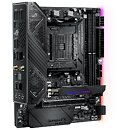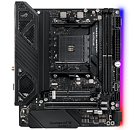- Joined
- Oct 9, 2007
- Messages
- 47,293 (7.53/day)
- Location
- Hyderabad, India
| System Name | RBMK-1000 |
|---|---|
| Processor | AMD Ryzen 7 5700G |
| Motherboard | ASUS ROG Strix B450-E Gaming |
| Cooling | DeepCool Gammax L240 V2 |
| Memory | 2x 8GB G.Skill Sniper X |
| Video Card(s) | Palit GeForce RTX 2080 SUPER GameRock |
| Storage | Western Digital Black NVMe 512GB |
| Display(s) | BenQ 1440p 60 Hz 27-inch |
| Case | Corsair Carbide 100R |
| Audio Device(s) | ASUS SupremeFX S1220A |
| Power Supply | Cooler Master MWE Gold 650W |
| Mouse | ASUS ROG Strix Impact |
| Keyboard | Gamdias Hermes E2 |
| Software | Windows 11 Pro |
ASUS over the past week rolled out its flagship socket AM4 motherboard for SFF gaming PC builds, the ROG Crosshair VIII Impact. Based on the AMD X570 chipset and supporting the latest 3rd generation Ryzen processors, this board is slightly longer than the Mini-ITX specification, while retaining its mount-hole layout. The logic here is that most ITX gaming PC cases have two expansion slots to accommodate dual-slot graphics cards, and so it would make sense to extend the motherboard's PCB up until there, reclaiming precious PCB real-estate. Technically this board would qualify as mini-DTX, but ASUS believes it should fit in most ITX cases that have two expansion slots. The board's dimensions are 203 mm x 170 mm.
The ROG Crosshair VIII Impact draws power from a combination of 24-pin ATX and 8-pin EPS connectors, conditioning power for the AM4 SoC using a massive 8-phase VRM. The AM4 socket is wired to a pair of DDR4 DIMM slots, the board's sole expansion slot, a PCI-Express 4.0 x16, and the interestingly-named SO-DIMM.2 slot. Physically, this is an SO-DIMM slot that's been re-wired with PCIe gen 4.0 leading up to a proprietary SO-DIMM daughterboard that holds two M.2-2280 slots with PCIe 4.0 x4 and SATA 6 Gbps wiring, each. Four SATA 6 Gbps ports make for the rest of the storage connectivity. The area of the motherboard just below the PCIe x16 slot has another proprietary slot that holds the second daughterboard, this one with the SupremeFX Impact IV onboard audio solution, which has been physically isolated from the main PCB, and has an EMI-shielded Realtek ALC1220 main CODEC, ESS Sabre ES9023P DAC for the main stereo channel, a de-pop circuit, and audio-grade capacitors.





The chipset and VRM are cooled by an elaborate compound heatsink arrangement similar to the one on the ROG Strix X570-I Gaming, which is located near the rear I/O area, and uses a pair of fans for active cooling. The board uses a metal back-plate for additional heat dissipation. Networking options include 802.11ax Wi-Fi 6 WLAN, Bluetooth 5.0, and gigabit Ethernet, all driven by Intel-made controllers. USB connectivity includes a staggering six 10 Gbps USB 3.1 ports, one of which is type-C, and four 5 Gbps ports, two of which are located at the rear panel, four by headers. The rear I/O features the board's POST code display, and buttons for clear-CMOS, USB BIOS Flashback, and reset. There are power, POST retry, and failsafe boot buttons on the board. ASUS is pricing the ROG Crosshair VIII Impact around the USD $450-mark.
View at TechPowerUp Main Site
The ROG Crosshair VIII Impact draws power from a combination of 24-pin ATX and 8-pin EPS connectors, conditioning power for the AM4 SoC using a massive 8-phase VRM. The AM4 socket is wired to a pair of DDR4 DIMM slots, the board's sole expansion slot, a PCI-Express 4.0 x16, and the interestingly-named SO-DIMM.2 slot. Physically, this is an SO-DIMM slot that's been re-wired with PCIe gen 4.0 leading up to a proprietary SO-DIMM daughterboard that holds two M.2-2280 slots with PCIe 4.0 x4 and SATA 6 Gbps wiring, each. Four SATA 6 Gbps ports make for the rest of the storage connectivity. The area of the motherboard just below the PCIe x16 slot has another proprietary slot that holds the second daughterboard, this one with the SupremeFX Impact IV onboard audio solution, which has been physically isolated from the main PCB, and has an EMI-shielded Realtek ALC1220 main CODEC, ESS Sabre ES9023P DAC for the main stereo channel, a de-pop circuit, and audio-grade capacitors.





The chipset and VRM are cooled by an elaborate compound heatsink arrangement similar to the one on the ROG Strix X570-I Gaming, which is located near the rear I/O area, and uses a pair of fans for active cooling. The board uses a metal back-plate for additional heat dissipation. Networking options include 802.11ax Wi-Fi 6 WLAN, Bluetooth 5.0, and gigabit Ethernet, all driven by Intel-made controllers. USB connectivity includes a staggering six 10 Gbps USB 3.1 ports, one of which is type-C, and four 5 Gbps ports, two of which are located at the rear panel, four by headers. The rear I/O features the board's POST code display, and buttons for clear-CMOS, USB BIOS Flashback, and reset. There are power, POST retry, and failsafe boot buttons on the board. ASUS is pricing the ROG Crosshair VIII Impact around the USD $450-mark.
View at TechPowerUp Main Site








